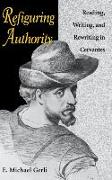- Start
- Refiguring Authority
Refiguring Authority
Angebote / Angebote:
In the prologue to Don Quixote, Cervantes maintains that his purpose in writing the work was to undo the pernicious moral and literary example of chivalric romances. Actually, argues E. Michael Gerli in this wide-ranging study, he often did much more. Cervantes and his contemporaries ceaselessly imitated one another - glossing works, dismembering and reconstructing them, writing for and against one another, while playing sophisticated games of literary one-upmanship. The result, says Gerli, is that literature in late Renaissance Spain was often more than a simple matter of source and imitation. It must be understood as a far more subtle, palimpsest-like process of forging endless series of texts from other texts, thus linking closely the practices of reading, writing, and rewriting. Like all major writers of the age, Cervantes was responding not just to specific literary traditions but to a broad range of texts and discourses. And he expected his well-read audience to recognize his sources and to appreciate their transformations. Modern literary theory has explicitly confirmed what Cervantes and his contemporaries intuitively knew - that reading and writing are closely linked dimensions of the literary enterprise. Other texts constitute an important source for understanding not only how Cervantes' works were composed but how these works were read, received, and rewritten by him and other writers of his age. Reading Cervantes and his contemporaries in this way enables us to comprehend the craft, wit, irony, and subtle conceit that lie at the heart of seventeenth-century Spanish literature.
Fremdlagertitel. Lieferzeit unbestimmt




